Genuine Alabaster Lighting
Aug 4th 2008

Q. What is alabaster?
A. Alabaster, in its pure form, is a mineral: a crystalline form of gypsum. The alabaster quarried is actually a rock frequently mixed with traces of other elements like iron—the dark veining—or quartz. There are three main types of alabaster: an opaque, chalky variety that is ground up and used in gypsum or plaster, a semi-transparent type called scaglione and the translucent kind used for the alabaster shades and fixtures that are imported today. The rocks, which are white with random amounts of translucent and mostly gray-brown veining when used for lighting, are taken from centuries-old quarries in Spain.
Q. Why is alabaster expensive?
A. The short answer: Quarrying alabaster is costly, and there is a huge amount of waste. Alabaster is a relatively delicate stone, and deposits near the surface have often been damaged by the weather. Therefore, huge steam shovels are used to scoop up usable chunks of alabaster from deeper underground. Next, artisans working with the "corazon," or heart, of the raw rock, turn alabaster pieces on a lathe to create the desired shape and then carefully finish and polish the soft stone. The waste averages about 75 percent but can be much more. The larger the finished bowl, the larger the stone it came from and the greater the waste.
Q. How can I tell the difference between genuine alabaster and an imitation?
A. When you see the real thing in person, you'll know it. Nothing glows like genuine alabaster. Just in case you're still not sure, some other things to look for are the thickness, weight and veining. Genuine alabaster is a minimum of 3/8-inch thick and weighs at least twice as much as imitations. Veins are both translucent and dark and are completely random. If you see two pieces that have the same veining pattern in the same location, they are not genuine.
It's easier to be fooled by a photo in a magazine or catalog and especially on the Internet than by looking at the actual product. In either case, an accurate product description is the responsibility of the manufacturer and retailer. Try doing a search for alabaster on eBay. The results include everything from Kate Spade "alabaster bone china" to an "alabaster pendant light" from a major manufacturer offered by a major U.S. lighting retailer. It's only after you click on the item and read the description that it turns out to be "alabaster glass." While the intent may not be to mislead, it's just not fair to the consumer.
Q. Should I even be concerned that it’s genuine Alabaster?
A. Great question. Though there are more and more imitations (China stone, cultured alabaster, faux alabaster acrylic), none of them replicate the real thing. An imitation is just that: an imitation. owning genuine alabaster lighting is just like owning Strass® crystal—it's not for everyone, but for those who can appreciate its value, imitation just won't do. Remember, knowledge is power: The more you know about it, the easier it is to discern.
Q. How do I clean genuine alabaster?
A. Alabaster is a soft stone, so treat it gently. Never use detergents or abrasives. Alabaster is porous, and both will damage it. Instead, wipe the stone with a slightly damp (not wet), soft cloth. If you take care of it, it will someday be a treasured antique that you can pass along to future generations.
